
Excalibur is the legendary sword of King Arthur, sometimes also attributed with magical powers or associated with the rightful sovereignty of Britain. It was associated with the Arthurian legend very early on. Excalibur and the Sword in the Stone are in some versions said to be different, though in most incarnations they are the same. In Welsh, it is called Caledfwlch; in Cornish, Calesvol ; in Breton, Kaledvoulc'h; and in Latin, Caliburnus. Several similar swords and other weapons also appear in this and other legends.

Idylls of the King, published between 1859 and 1885, is a cycle of twelve narrative poems by the English poet Alfred, Lord Tennyson which retells the legend of King Arthur, his knights, his love for Guinevere and her tragic betrayal of him, and the rise and fall of Arthur's kingdom.

In the Matter of Britain, Igraine is the mother of King Arthur. Igraine is also known in Latin as Igerna, in Welsh as Eigr, in French as Ygraine, in Le Morte d'Arthur as Ygrayne—often modernised as Igraine or Igreine—and in Parzival as Arnive. She becomes the wife of Uther Pendragon, after the death of her first husband, Gorlois.

The Lady of the Lake is a name or a title used by several fairy-like enchantresses in the Matter of Britain, the body of medieval literature and mythology associated with the legend of King Arthur. They play pivotal roles in many stories, including providing Arthur with the sword Excalibur, eliminating Merlin, raising Lancelot after the death of his father, and helping to take the dying Arthur to Avalon. Different sorceresses known as the Lady of the Lake appear concurrently as separate characters in some versions of the legend since at least the Post-Vulgate Cycle and consequently the seminal Le Morte d'Arthur, with the latter describing them as a hierarchical group, while some texts also give this title to either Morgan or her sister.

Excalibur is a 1981 British epic medieval fantasy film directed, produced, and co-written by John Boorman that retells the legend of King Arthur and the knights of the Round Table, based on the 15th-century Arthurian romance Le Morte d'Arthur by Thomas Malory. It stars Nigel Terry as Arthur, Nicol Williamson as Merlin, Nicholas Clay as Lancelot, Cherie Lunghi as Guenevere, Helen Mirren as Morgana, Liam Neeson as Gawain, Gabriel Byrne as Uther Pendragon, Corin Redgrave as Gorlois, Duke of Cornwall, and Patrick Stewart as Leondegrance. The film is named after the legendary sword of King Arthur that features prominently in Arthurian literature. The film's soundtrack features the music of Richard Wagner and Carl Orff, along with an original score by Trevor Jones.

The Knights of the Round Table are the knights in the fellowship of King Arthur in the literary cycle of the Matter of Britain, a French-derived branch of Arthurian legend, first appearing in literature in the mid-12th century. The Knights are an order dedicated to ensuring the peace of Arthur's kingdom following an early warring period, entrusted in later years to undergo a mystical quest for the Holy Grail. The Round Table at which they meet is a symbol of the equality of its members, who range from sovereign royals to minor nobles.

In Arthurian legend, Morgan le Fay, alternatively known as Morgan[n]a, Morgain[a/e], Morg[a]ne, Morgant[e], Morge[i]n, and Morgue[in] among other names and spellings, is a powerful enchantress. Early appearances of Morgan do not elaborate her character beyond her role as a goddess, a fay, a witch, or a sorceress, generally benevolent and related to King Arthur as his magical saviour and protector. Her prominence increased as legends developed over time, as did her moral ambivalence, and in some texts there is an evolutionary transformation of her to an antagonist, particularly as portrayed in cyclical prose such as the Lancelot-Grail and the Post-Vulgate Cycle. A significant aspect in many of Morgan's medieval and later iterations is the unpredictable duality of her nature, with potential for both good and evil.
Le Morte d'Arthur is a 15th-century Middle English prose reworking by Sir Thomas Malory of tales about the legendary King Arthur, Guinevere, Lancelot, Merlin and the Knights of the Round Table—along with their respective folklore. In order to tell a "complete" story of Arthur from his conception to his death, Malory compiled, rearranged, interpreted and modified material from various French and English sources. Today, this is one of the best-known works of Arthurian literature. Many authors since the 19th-century revival of the legend have used Malory as their principal source.

The Mists of Avalon is a 1983 historical fantasy novel by American writer Marion Zimmer Bradley, in which the author relates the Arthurian legends from the perspective of the female characters. The book follows the trajectory of Morgaine, a priestess fighting to save her Celtic religion in a country where Christianity threatens to destroy the pagan way of life. The epic is focused on the lives of Morgaine, Gwenhwyfar (Guinevere), Viviane, Morgause, Igraine and other women of the Arthurian legend.
The Queen of Orkney, today best known as Morgause and also known as Morgawse and other spellings and names, is a character in later Arthurian traditions. In some versions of the legend, including the seminal text Le Morte d'Arthur, she is the mother of Gawain and Mordred, both key players in the story of King Arthur and his downfall. Mordred is the offspring of Arthur's accidental incest with Morgause, the king's estranged half-sister. She is furthermore a sister of Morgan le Fay and the wife of King Lot of Orkney, as well as the mother of Gareth, Agravain, and Gaheris, the last of whom murders her.

Sir Gareth is a Knight of the Round Table in Arthurian legend. He was the youngest son of King Lot and Queen Morgause, King Arthur's half-sister, thus making him Arthur's nephew, as well as brother to Gawain, Agravain, and Gaheris, and either a brother or half-brother of Mordred. He is particularly notable in Le Morte d'Arthur where he is also known by his nickname Beaumains.

Morgaine le Fey is a character based on St Eurgain, daughter of Welsh King, Maelgwn Gwynedd, who would become a supervillainess published by DC Comics. She debuted in The Demon vol. 1 #1, and was created by Jack Kirby. The character is based on Morgan le Fay, the mythical sorceress and half-sister of King Arthur first made popular in Geoffrey of Monmouth's Vita Merlini.

Merlin is a three-part 1998 television miniseries which originally aired on NBC that retells the legend of King Arthur from the perspective of the wizard Merlin.

Sir Balin le Savage, also known as the Knight with the Two Swords, is a character in the Arthurian legend. Like Sir Galahad, Sir Balin is a late addition to the medieval Arthurian world. His story, as told by Thomas Malory in Le Morte d'Arthur, is based upon that told in the continuation of the second book of the Post-Vulgate cycle of legend, the Suite du Merlin.

The Knight of the Sacred Lake is a historical fantasy novel by Rosalind Miles. It was first published in 2000 by Simon & Schuster in the UK followed by Crown Books in the US. The book is a retelling of the Arthurian legend and follows the lives of Queen Guinevere, consort of King Arthur and her struggles with the king's nephews Agravain and Gawain; the queen is torn between her love for her husband, her land, and her lover, Lancelot. The book was part of a series, The Guinevere Novels, and was followed by The Child of the Holy Grail. Reviewing the book, Publishers Weekly described it as "a lush, feminist take on the English epic".

King Arthur and the Knights of the Round Table is a Japanese anime series based on Arthurian legend. Produced by Toei Animation, the series consists of 30 half-hour episodes released between 9 September 1979 and 3 March 1980. The series achieved great popularity in its non-English translations.

The Sword and the Circle, King Arthur and the Knights of the Round Table is a children's novel written by Rosemary Sutcliff and was first published in 1981. The story is a retelling of the story of King Arthur and his Knights of the Round Table. According to her own statements in the introduction, The Sword and the Circle follows the myths and folktales of King Arthur, crediting inspiration primarily from Sir Thomas Malory's Le Morte d'Arthur; other sources include Geoffrey of Monmouth's Historia Regum Britanniae, English ballads, and Irish folktales. She contrasts this telling of the King Arthur story with her previous novels, The Lantern Bearers and Sword at Sunset, which were more an attempt to connect with a concrete historical figure behind the folktales.

The Story of King Arthur and His Knights is a 1903 children's novel by the American illustrator and writer Howard Pyle. The book contains a compilation of various stories, adapted by Pyle, regarding the legendary King Arthur of Britain and select Knights of the Round Table. Pyle's novel begins with Arthur in his youth and continues through numerous tales of bravery, romance, battle, and knighthood.

Cursed is an American fantasy drama streaming television series that premiered on Netflix on July 17, 2020. It is based on the illustrated novel of the same name by Frank Miller and Tom Wheeler. The set location of the series is the United Kingdom. In July 2021, the series was canceled after one season.
















